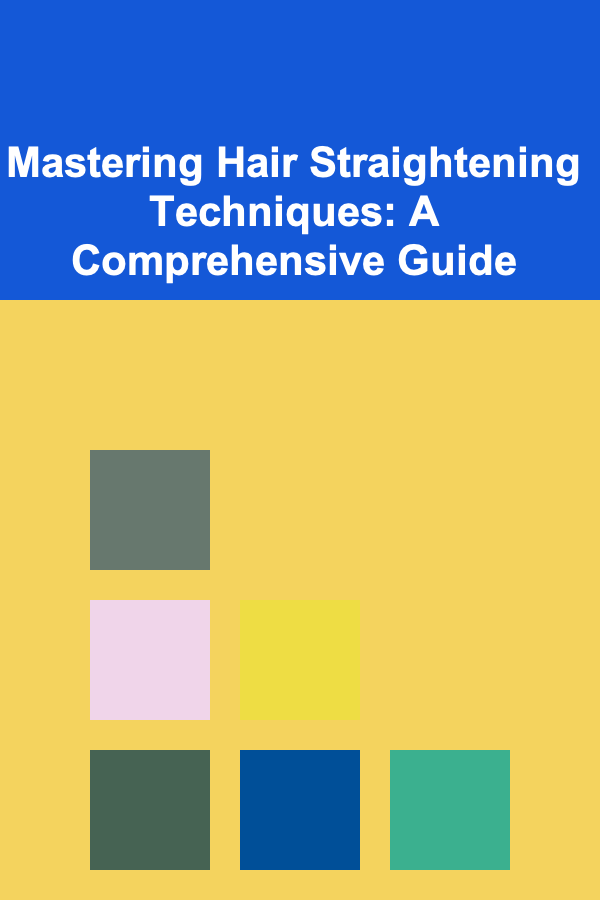
Mastering Hair Straightening Techniques: A Comprehensive Guide
ebook include PDF & Audio bundle (Micro Guide)
$12.99$8.99
Limited Time Offer! Order within the next:

Achieving sleek, straight hair is a goal for many, but the path to mastering hair straightening techniques can be fraught with potential damage and frustration. This comprehensive guide delves into the intricacies of hair straightening, covering everything from understanding your hair type and selecting the right tools to mastering techniques and protecting your hair from heat damage. We will explore various straightening methods, debunk common myths, and provide expert tips for achieving salon-worthy results at home.
Understanding Your Hair Type: The Foundation of Successful Straightening
Before even considering picking up a straightener, it's crucial to understand your unique hair type. Hair type dictates how it reacts to heat, moisture, and products, and significantly influences the straightening process.
Identifying Your Hair Texture
Hair texture is primarily categorized into four main types: straight (Type 1), wavy (Type 2), curly (Type 3), and coily (Type 4). Within each type, there are further subdivisions (A, B, and C) based on the tightness of the curl pattern.
- Type 1 (Straight): Characterized by a lack of natural curl. Subtypes range from fine and thin (1A) to thick and coarse (1C). Straight hair tends to be the oiliest because the sebum from the scalp can easily travel down the hair shaft.
- Type 2 (Wavy): Features a slight S-shaped pattern. 2A hair is loose and barely-there waves, 2B has medium waves that lie closer to the head, and 2C waves are wider and often prone to frizz.
- Type 3 (Curly): Defined by well-formed curls, ranging from loose loops to tight spirals. 3A curls are large and loose, 3B curls are springier and tighter, and 3C curls are tightly packed and can resemble corkscrews.
- Type 4 (Coily): Tightly coiled and often fragile. 4A coils are tightly curled with an S-pattern, 4B coils have a Z-pattern with sharp angles, and 4C coils are the tightest and most prone to shrinkage.
Porosity: How Well Does Your Hair Absorb Moisture?
Porosity refers to your hair's ability to absorb and retain moisture. This is another crucial factor in determining the best straightening approach.
- Low Porosity: Hair has tightly bound cuticles, making it difficult for moisture to penetrate. Products tend to sit on the surface, and it can take longer for hair to dry.
- Medium Porosity: The cuticle is moderately open, allowing for balanced moisture absorption and retention. This hair type generally responds well to most products and styling techniques.
- High Porosity: The cuticle is widely open, allowing moisture to be absorbed quickly but also lost just as rapidly. Hair is often dry, brittle, and prone to frizz.
Density: How Thick Is Your Hair?
Hair density refers to the number of individual hair strands per square inch on your scalp. Density can be classified as low, medium, or high.
- Low Density: Thin hair with visible scalp.
- Medium Density: Average thickness.
- High Density: Thick and voluminous hair.
Understanding these three characteristics---texture, porosity, and density---will inform your product choices, heat settings, and overall straightening strategy. For example, low porosity hair may require pre-heating treatments to open the cuticle, while high porosity hair needs deep conditioning treatments to seal in moisture after straightening.
Choosing the Right Tools and Products: A Crucial Investment
The tools and products you use can significantly impact the health and appearance of your straightened hair. Investing in high-quality options is essential for minimizing damage and achieving optimal results.
Selecting the Right Hair Straightener
Hair straighteners, also known as flat irons, come in various materials, sizes, and with different features. Here's a breakdown of the most common types:
- Ceramic Straighteners: Heat up quickly and evenly, distributing heat more consistently across the hair. They are a good choice for most hair types, especially fine or damaged hair.
- Tourmaline Straighteners: Emit negative ions that help to neutralize positive ions in the hair, reducing frizz and static. They are excellent for creating smooth, shiny results and are particularly beneficial for dry or frizzy hair.
- Titanium Straighteners: Heat up very quickly and maintain high temperatures. They are suitable for thick, coarse, or resistant hair but can be damaging to finer hair types if used improperly.
- Adjustable Temperature Settings: A must-have feature! Allows you to customize the heat based on your hair type and condition.
- Plate Size: Wider plates are ideal for longer, thicker hair, while narrower plates are better for shorter hair, bangs, or creating curls and waves.
- Automatic Shut-Off: A safety feature that automatically turns off the straightener after a period of inactivity.
Warning: Avoid straighteners with uneven heating or poorly constructed plates, as these can cause hot spots and lead to uneven straightening and potential damage.
Essential Hair Straightening Products
Using the right products before, during, and after straightening is crucial for protecting your hair and achieving long-lasting results.
- Heat Protectant Spray: An absolute essential! Creates a barrier between your hair and the heat, minimizing damage from high temperatures. Apply liberally to damp or dry hair before straightening. Look for options containing ingredients like silicones, keratin, or natural oils.
- Smoothing Serum or Oil: Helps to tame frizz, add shine, and protect hair from humidity. Apply a small amount to damp or dry hair after straightening. Argan oil, coconut oil (use sparingly!), and jojoba oil are popular choices.
- Anti-Frizz Products: Especially important for those with frizzy or humid-prone hair. Look for serums, creams, or sprays that contain ingredients like silicones or humectants.
- Deep Conditioner: Use regularly (at least once a week) to replenish moisture and repair damage.
- Clarifying Shampoo: Use occasionally to remove product buildup that can weigh down hair and prevent it from straightening properly.
Tip: Read product labels carefully and choose products that are specifically formulated for your hair type and concerns.
Mastering the Straightening Technique: Step-by-Step Guide
The technique you use is just as important as the tools and products you choose. Proper technique minimizes damage and ensures a smooth, even finish.
Step 1: Preparation is Key
- Wash and Condition Your Hair: Start with clean, conditioned hair. Use a moisturizing shampoo and conditioner to hydrate your hair.
- Towel Dry Gently: Avoid rubbing your hair vigorously with a towel, as this can cause breakage and frizz. Instead, gently pat your hair dry or use a microfiber towel.
- Apply Heat Protectant: Spray heat protectant liberally throughout your hair, ensuring even coverage.
- Detangle Thoroughly: Use a wide-tooth comb or a detangling brush to remove any knots or tangles.
- Rough Dry (Optional): If you have thick or coarse hair, you may want to rough dry your hair with a blow dryer on a low heat setting before straightening. This will help to remove excess moisture and speed up the straightening process. Don't aim for completely dry hair; slightly damp is ideal.
Step 2: Straightening Your Hair
- Section Your Hair: Divide your hair into small, manageable sections (about 1-2 inches wide). This will ensure that each section is straightened evenly. Use clips to hold the sections out of the way.
- Set the Temperature: Choose the appropriate temperature setting for your hair type.
- Fine or Damaged Hair: 250-300°F (120-150°C)
- Medium Hair: 300-350°F (150-180°C)
- Thick or Coarse Hair: 350-400°F (180-200°C)
- Straighten Each Section: Starting at the roots, clamp the straightener onto a section of hair. Gently glide the straightener down the hair shaft in a smooth, even motion. Avoid stopping or holding the straightener in one spot for too long, as this can cause heat damage.
- Repeat as Necessary: Repeat the straightening process on each section of hair until it is completely straight. You may need to go over some sections more than once, especially if you have thick or curly hair.
- Focus on the Roots: Pay special attention to the roots, as this is where hair tends to be the most curly or wavy.
Step 3: Finishing Touches
- Apply Smoothing Serum or Oil: Once you have finished straightening your hair, apply a small amount of smoothing serum or oil to tame frizz and add shine.
- Style as Desired: Style your hair as desired. You can leave it straight, add some waves, or create an updo.
- Hairspray (Optional): If you want to hold your style in place, you can use a light-hold hairspray.
Tip: For a smoother, more polished look, try using a comb to guide the straightener down the hair shaft. This will help to keep the hair strands aligned and prevent kinks or bends.
Advanced Techniques and Considerations
Beyond the basic technique, there are several advanced techniques and considerations that can elevate your hair straightening skills and minimize potential damage.
Root Lifting Techniques
Adding volume at the roots is crucial for preventing flat, lifeless hair after straightening. Several techniques can help achieve this:
- Over-Direction: Lift the hair section at a 45-degree angle away from the scalp when straightening the roots. This creates lift and volume.
- Round Brushing: Use a round brush to lift the roots while blow-drying before straightening. This adds volume and smoothness.
- Root Lifting Products: Apply a root lifting spray or mousse to damp hair before blow-drying or straightening.
Creating Curls and Waves with a Straightener
Believe it or not, a straightener can also be used to create beautiful curls and waves. This technique requires practice but can offer a versatile alternative to using a curling iron.
- Start Near the Roots: Clamp a section of hair near the roots.
- Rotate the Straightener: Rotate the straightener 180 degrees away from your face.
- Glide Down the Hair Shaft: Glide the straightener down the hair shaft, maintaining the rotation. The speed at which you glide will determine the tightness of the curl.
- Repeat for All Sections: Repeat the process for all sections of hair.
- Loosen the Curls: Once you have finished curling your hair, you can loosen the curls by running your fingers through them or using a wide-tooth comb.
Dealing with Stubborn Areas
Some areas of the hair, such as the roots, nape of the neck, or hairline, may be more difficult to straighten than others. Here are some tips for dealing with these stubborn areas:
- Smaller Sections: Use smaller sections of hair when straightening these areas.
- Lower Temperature: Use a lower temperature setting to avoid damaging the hair.
- Multiple Passes: You may need to go over these areas more than once to achieve the desired results.
Straightening Hair with Extensions
If you have hair extensions, it's important to take extra care when straightening them. Human hair extensions can typically be straightened like your natural hair, but synthetic extensions may melt or become damaged by heat.
- Check the Material: Determine whether your extensions are made of human hair or synthetic fibers.
- Use a Low Temperature: If straightening human hair extensions, use a low temperature setting.
- Avoid the Bonds: Be careful not to apply heat directly to the bonds of the extensions, as this can weaken them.
- Test on a Hidden Section: Before straightening all of your extensions, test the heat on a small, hidden section to ensure that they can withstand the heat.
Protecting Your Hair from Heat Damage: Long-Term Hair Health
Heat damage is a significant concern for anyone who regularly straightens their hair. Implementing preventative measures and adopting a consistent hair care routine is essential for maintaining healthy, strong hair.
The Importance of Heat Protectant
Heat protectant is the first line of defense against heat damage. It creates a barrier between the hair and the heat, minimizing moisture loss and cuticle damage. Apply liberally to damp or dry hair before using any heat styling tools.
Deep Conditioning Treatments
Deep conditioning treatments help to replenish moisture, repair damage, and strengthen hair. Use a deep conditioner at least once a week, or more often if your hair is dry or damaged. Look for products containing ingredients like keratin, argan oil, or shea butter.
Regular Trims
Regular trims are essential for removing split ends and preventing them from traveling up the hair shaft. Trim your hair every 6-8 weeks to maintain healthy, strong ends.
Limiting Heat Exposure
While heat protectant can help to minimize damage, it's still important to limit heat exposure as much as possible. Avoid straightening your hair every day, and consider air-drying your hair whenever possible.
Using Lower Heat Settings
Whenever possible, use lower heat settings on your straightener. This will minimize the risk of heat damage.
Proper Nutrition and Hydration
Healthy hair starts from within. Eating a balanced diet rich in vitamins, minerals, and protein, and staying hydrated, can contribute to strong, healthy hair.
Debunking Common Hair Straightening Myths
There are many misconceptions surrounding hair straightening. Let's address some of the most common myths:
- Myth: Straightening your hair will permanently damage it. While frequent straightening can cause damage, using proper techniques and protecting your hair can minimize the risk.
- Myth: You can only straighten your hair when it's completely dry. Slightly damp hair can actually be easier to straighten, but avoid straightening soaking wet hair.
- Myth: The higher the heat setting, the straighter your hair will be. Using excessively high heat can cause significant damage. Use the lowest heat setting that effectively straightens your hair.
- Myth: All straighteners are the same. The material, quality, and features of a straightener can significantly impact its performance and potential damage.
- Myth: You don't need heat protectant if you use a low heat setting. Heat protectant is always recommended, regardless of the heat setting.
Troubleshooting Common Straightening Problems
Even with the best techniques and products, you may encounter some common straightening problems. Here's how to troubleshoot them:
- Frizz: Use anti-frizz products, smoothing serums, and avoid over-drying your hair.
- Lack of Shine: Use shine-enhancing products, such as hair oils or serums.
- Flat Hair: Use root lifting techniques and volumizing products.
- Uneven Straightening: Section your hair carefully and straighten each section evenly.
- Heat Damage: Use heat protectant, limit heat exposure, and deep condition regularly.
Maintaining Your Straightened Hair: Long-Lasting Results
Once you've achieved your desired straight style, maintaining it is key to extending its longevity.
- Wrap Your Hair at Night: Wrapping your hair in a silk or satin scarf or bonnet helps to prevent frizz and tangles while you sleep.
- Use a Silk or Satin Pillowcase: A silk or satin pillowcase can also help to reduce friction and prevent frizz.
- Dry Shampoo: Use dry shampoo to absorb excess oil and refresh your hair between washes.
- Avoid Excessive Moisture: Humidity can cause straightened hair to revert back to its natural texture. Avoid exposing your hair to excessive moisture.
- Touch-Ups: Touch up your hair as needed to maintain its straight style.
Conclusion: Embracing the Art of Hair Straightening
Mastering hair straightening techniques is a journey that requires understanding your hair type, investing in quality tools and products, and practicing proper techniques. By following the guidelines outlined in this comprehensive guide, you can achieve sleek, straight hair while minimizing the risk of damage and maintaining the overall health and beauty of your locks. Remember that consistency, patience, and a commitment to hair care are essential for achieving long-lasting, salon-worthy results. Embrace the art of hair straightening, and enjoy the confidence that comes with beautifully styled hair.

How to Implement a Weekly Maintenance Routine for Your Bathroom Cabinet
Read More
How to Make Money Online as a LinkedIn Strategist: 10 Actionable Ideas
Read More
How to Maximize Bathroom Storage with Clever Organization Tips
Read More
How to Price Your Products for Maximum Profit When Selling Online
Read More
How To Support Reforestation Efforts for Wildlife
Read More
How to Utilize ChatGPT for Business Plan Drafting
Read MoreOther Products

How to Implement a Weekly Maintenance Routine for Your Bathroom Cabinet
Read More
How to Make Money Online as a LinkedIn Strategist: 10 Actionable Ideas
Read More
How to Maximize Bathroom Storage with Clever Organization Tips
Read More
How to Price Your Products for Maximum Profit When Selling Online
Read More
How To Support Reforestation Efforts for Wildlife
Read More